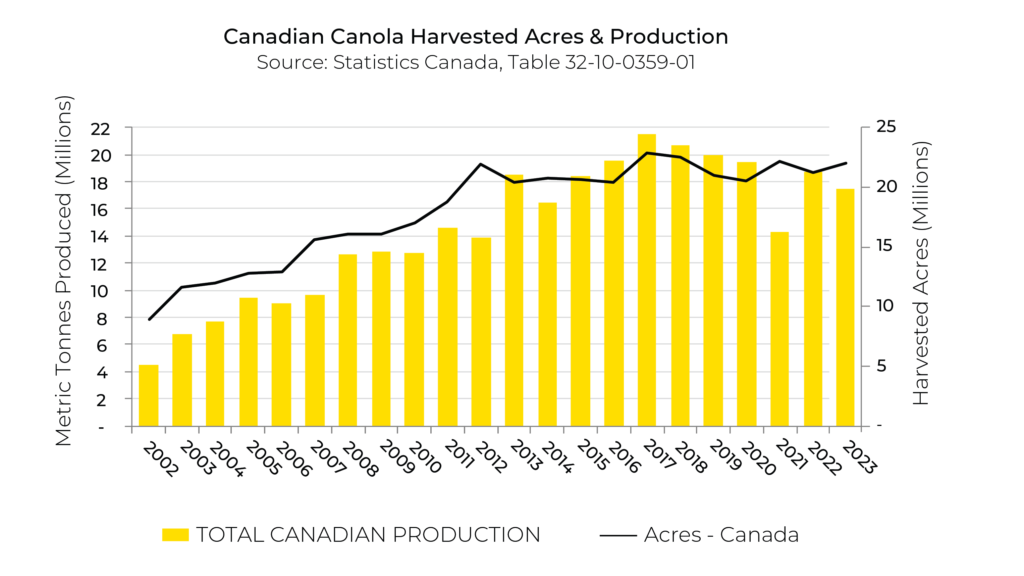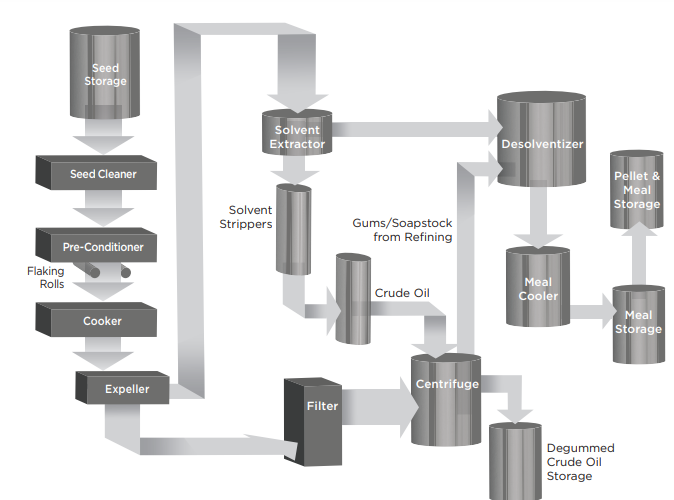

Browse the Canola Meal Feed Guide by chapter:
Canola is one of Canada’s most important crops and is also the second most traded vegetable protein ingredient in the world. The vast, fertile fields of Western Canada are the primary canola production region. In early summer, canola fields dot the countryside with brilliant yellow flowers, yielding between 18-20 million metric tonnes of canola each fall. These tiny round seeds, containing approximately 44% oil, are extracted for use as one of the world’s healthiest culinary oils. After the oil is extracted, the seed solids are processed into a protein-packed meal coproduct that is an excellent addition to livestock feed.
The name “canola” (Canadian oil) was coined in order to differentiate it from rapeseed. Canola is an offspring of rapeseed (Brassica napus and Brassica campestris/rapa), that was bred through traditional plant breeding techniques to have low levels of anti-nutrients, specifically erucic acid (< 2%) in the oil portion and low levels of glucosinolates (< 30 μmol/g) in the meal portion. The near removal of the glucosinolates in canola results in a meal that is highly palatable to livestock. Some European countries use the term “double-zero rapeseed” (low erucic acid, low glucosinolates) to characterize the modified “canola quality” seed, oil and meal.
Canola production in Canada has been steadily increasing, and currently sits at approximately 18-20 million metric tonnes of canola seed per year. The Canadian canola industry is targeting an increase in yield to reach 26 million metric tonnes of production per year, in response to rising world demand. The plan focuses on increasing yields in a sustainable way, while building consumer understanding of canola’s value and achieving stable, open trading relationships. As Figure 1 shows, canola production has risen steadily over the last two decades.
Global demand for canola oil and meal continues to grow, spurring investments in new processing capacity here in Canada. From 2021 to 2023, there were five major announcements to add 6.7 MMT of processing capacity in the next several years – representing a 60% increase from the current capacity of 11.1 MMT. This expansion will result in additional canola meal available for export from Canada to countries such as the U.S., China, Mexico and the Indo-Pacific region. About half of Canada’s canola seed is exported, and the other half is processed in Canada (Table 1). Most countries that import canola seed mainly do so for the oil, which is the most valuable component. The seed is processed, and the resulting canola meal is used for the animal feed industry in these countries. Canola meal is widely available and traded, usually sold in bulk form as mash or pellets.

Figure 1. Total production and acres of canola from 2002 through 2023.
Canadian canola meal is traded under the rules outlined in Table 2. Canola and rapeseed meals are commonly used in animal feeds around the world. Together, they are the second most widely traded protein ingredients after soybean meal. The major producers of canola and rapeseed meal are Canada, Australia, China, the European Union and India. The use of canola meal varies considerably from market to market. Canola meal sold directly to the United States goes primarily to the top dairy producing states. Canola seed exported to other countries for processing is used in a much more diverse fashion, including feeding to pigs, poultry and fish. Similarly, the meal that is used by the Canadian livestock industry goes primarily to dairy, swine and poultry rations.
Table 1. Canadian production, exports and domestic use of canola seed and canola meal (in 000’s) Metric tonnes1
| wdt_ID | Crop Year | 2019/2020 | 2020/2021 | 2021/2022 | 2022/2023 |
|---|---|---|---|---|---|
| 1 | Total seed production | 19,912.00 | 19,485.00 | 13,757.00 | 18,174.00 |
| 2 | Total seed export | 10,038.00 | 10,585.00 | 5,248.00 | 7,944.00 |
| 3 | China | 1,926.00 | 2,714.00 | 1,265.00 | 4,608.00 |
| 4 | Japan | 2,140.00 | 2,323.00 | 1,383.00 | 1,101.00 |
| 5 | Mexico | 1,154.00 | 1,374.00 | 1,035.00 | 1,208.00 |
| 6 | United Arab Emirates | 989.00 | 997.00 | 307.00 | 169.00 |
| 7 | Pakistan | 691.00 | 660.00 | 64.00 | 267.00 |
| 8 | European Union | 2,177.00 | 1,751.00 | 625.00 | 215.00 |
| 9 | United States | 495.00 | 429.00 | 537.00 | 320.00 |
| 10 | Other countries | 467.00 | 337.00 | 33.00 | 56.00 |
| 11 | Domestic seed processing | 10,129.00 | 10,425.00 | 8,555.00 | 9,961.00 |
| 12 | Domestic meal use | 737.00 | 625.00 | 649.00 | 528.00 |
| 13 | Total meal export | 4,904.00 | 5,261.00 | 4,516.00 | 5,311.00 |
| 14 | United States | 3,466.00 | 3,581.00 | 2,920.00 | 3,484.00 |
| 15 | China | 1,417.00 | 1,577.00 | 1,587.00 | 1,819.00 |
| 16 | Other Export | 21.00 | 103.00 | 9.00 | 8.00 |
1 Statistics Canada
Table 2. Trading rules for canola meal as set by Canadian Oilseed Processors Association (COPA)1
| wdt_ID | CHARACTERISTIC (AS FED) | CANADA AND U.S. | EXPORT |
|---|---|---|---|
| 1 | Protein, % minimum | 36 minimum | 36 minimum |
| 2 | Fat (oil) (typical), solvent extracted, % by mass | 2 minimum | 2 minimum |
| 3 | Fat (oil) (typical), expeller pressed, % by mass | 10 minimum | 10 minimum |
| 4 | Moisture, % by mass | 12 maximum | 12 maximum |
| 5 | Crude Fibre, % by mass | 12 maximum | 12 maximum |
| 6 | Sand and/or silica, % by mass | – | 1 maximum |
1 COPA (Canadian Oilseed Processors Association), 2019
Most canola seed is processed using solvent extraction in order to separate the oil from the meal. This process, also called prepress solvent extraction, typically includes (Figure 2):
A small proportion of Canadian canola seed is processed by using expeller processing, also termed double pressing. The seed is expelled twice to extract oil rather than using solvent to extract the residual oil. Up to the point of solvent extraction, the process is similar to the traditional preprocess solvent extraction process. However, it excludes the solvent extraction, desolventization, and drying and cooling stages. The resulting meal has higher oil content, which can range from 8–11%.
The quality of the meal can be both enhanced and diminished by altering the processing conditions in the processing plant. Minimum processing temperatures are needed in order to deactivate the myrosinase enzyme, which, if not destroyed, will break down glucosinolates into their toxic metabolites (aglucones) in the animal’s digestive tract. Canola processing can also cause thermal degradation of 30–70% of glucosinolates in the meal (Daun and Adolphe, 1997). However, if temperatures are too high for too long, then the protein quality of the meal can decrease. Canola meal quality from processing plants within Canada does not vary widely. Small scale processing, where there is considerable variation in processing temperatures may produce meal of varied quality.

Figure 2. Schematic of prepress solvent extraction process
COPA, 2019. Canadian Oilseed Processors Association. Trading rules. https://copacanada.com/trading-rules/, Winnipeg, Manitoba
Daun, J.K. and Adolphe, D. 1997. A revision to the canola definition. GCIRC Bulletin. July 1997. pp.134–141
Questions? Contact us.